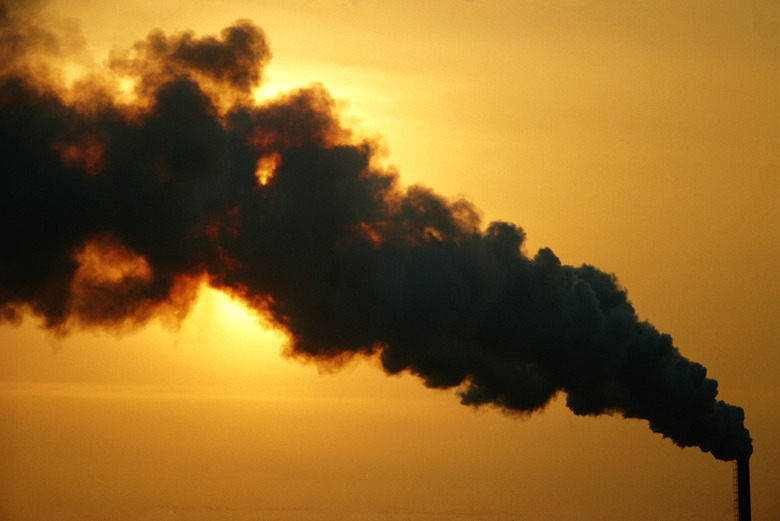How Does Pollution Affect Animal Genetics?
Pollution in the environment includes increased carbon and other chemicals in the air, agricultural nutrient run-off, pharmaceutical waste in aquatic systems, leakage from landfills, reservoirs of human feces, trash in terrestrial and aquatic systems and everything in between. Though it's easy to see the effect of trash on large animals, the potentially damaging effects on genetics are largely unidentified. Additionally, with the advent of genetically modified plants and animals, genetic pollution by modified organisms into natural populations is an emerging concern.
Genetic Diversity and Mutations
Genetic Diversity and Mutations
Chemical pollutants that make their way into animals' systems have been shown to cause direct changes to genetic diversity. For example, one study found exposure to heavy metals from smelter plants in Finland and Russia as well as radioactive isotopes from a nuclear processing plant in Russia to cause an increase in genetic diversity for wild populations of the great tit and an opposing decrease in populations of the pied flycatcher. Air pollution falling into the environment from steel mills in Hamilton, Ontario, has been linked to an increase in the rate of genetic mutations in the offspring of both gulls and mice. These results are not localized. Similar studies after the Chernobyl nuclear accident reported increased mutation rates in bird and rodent populations. Heavy metals have been linked to DNA damage in bird and mammal populations, which have shown elevated numbers of gene mutations in industrial areas. There has been no record of physical, behavior or survival rate changes in these species; but effects have been localized to only a few generations.
Asymmetry
Asymmetry
Environmental pollution causes a number of physical problems in animals, including increased rates of disease, such as cancer, and altered hormone levels and reproduction; though these have not been linked to a genetic change. Since the late 1980s, body symmetry has been used as an indicator of genetic and developmental regularity. Asymmetry is a physical change that signals genetic abnormality. In trout, mice and birds, environmental pollution results in asymmetry, in the form of enlarged physical traits on one side of the body. Asymmetry occurs in all parts of the body, but more so in traits like ornaments that are used to attract mates. In swallows and zebra finches, birds with asymmetric ornaments reproduce less, and their offspring have lower survival rates. In traits that do not affect reproduction, like foot size in squirrels and mice and fin size in trout, asymmetry causes an increased susceptibility to predators and decreased survival. Genetically, asymmetry also suggests decreased genetic diversity leading to inability to respond appropriately to stress.
Genetic Pollution
Genetic Pollution
Genetic pollution occurs when wild populations mix with or are affected by genetically modified organisms. For crops, wild populations become extinct when outcompeted by those that have been modified to be resistant to chemicals and consumption by insects. Insect species also become locally extinct and show higher mutation rates when feeding on crops that are genetically modified to produce insecticides.This suggests mutations and altered survival may occur in other, larger herbivores. Bacteria living on genetically modified crops in India have shown increased resistance to antibiotics, one of which is prevalently used to treat tuberculosis in the region. As bacterial resistance increases, it could cause the spread of disease in the human population to increase. Genetic pollution can also occur through the mating of wild and modified organisms, producing hybrids. This has occurred in the United States, India and throughout Europe with plants from mustard to turnip, radish, oilseed rape and more, but the consequences of these genetic changes to natural populations have yet to be seen.
Genetic Susceptibility and Evolution
Genetic Susceptibility and Evolution
Some animal populations are more susceptible than others to the effects of pollution exposure. Increased susceptibility shows up in the form of more frequent illness and decreased reproduction rates. These effects can combine causing the eventual extinction of local, susceptible populations. In mice, susceptibility to ozone pollution has been linked to the same chromosome as susceptibility to sulfur particles. This suggests an increased likelihood of localized extinction in susceptible populations.
Microbial Genetic Effects
Microbial Genetic Effects
Environmental pollution has caused a number of genetic effects in the microbial community, from antibiotic and antifungal resistance to increasing microbial diversity. Increased amounts of pharmaceuticals in water systems challenge microbes to become resistant to a broader class of antimicrobial drugs. For example, E. coli isolated from Shipyard Creek in South Carolina, which was polluted by toxic metals and other industrial wastes, has been shown to be resistant to nine different classes of antibiotics. As microbes in the environment change and potentially grow more virulent and pathogenic, their effect on the animals they come in contact with will change as well.
References
- BioTech Articles: Effects of Genetic Pollution in Plants and Animals
- Environmental News Network: Arctic Genetic Pollution Effects
- Mutation Research: Environmental Pollution Affects Genetic Diversity in Wild Bird Populations
- Genome News Network: Air Pollution Cause Genetic Mutations
- Colorado State University: Genetics and Animal Welfare
- European Respiratory Journal: Genetic Aspects of Susceptibility to Air Pollution
- Popular Science: Bacterial Live at 33,000 Feet
- Applied and Environmental Microbiology: Microbial Diversity of a Heavily Polluted Microbial Mat and Its Community Changes Following Degradation of Petroleum Compounds
Cite This Article
MLA
Andras, Tiffany. "How Does Pollution Affect Animal Genetics?" sciencing.com, https://www.sciencing.com/pollution-affect-animal-genetics-23866/. 24 April 2017.
APA
Andras, Tiffany. (2017, April 24). How Does Pollution Affect Animal Genetics?. sciencing.com. Retrieved from https://www.sciencing.com/pollution-affect-animal-genetics-23866/
Chicago
Andras, Tiffany. How Does Pollution Affect Animal Genetics? last modified August 30, 2022. https://www.sciencing.com/pollution-affect-animal-genetics-23866/
